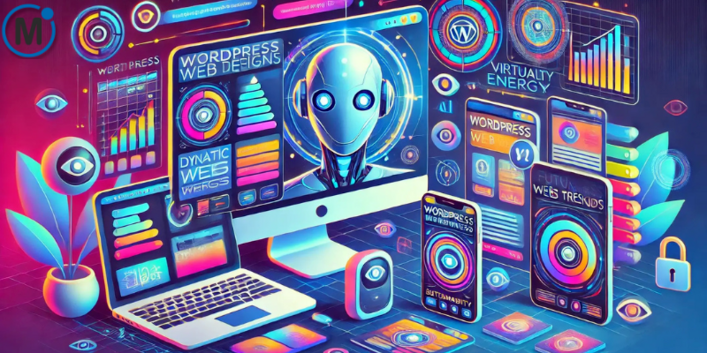
In this blog post, we’ll explore some of the latest trends shaping the landscape of web development in 2024 and how developers can leverage these trends to create innovative and user-centric web experiences.
𝟏. 𝐀𝐈-𝐏𝐨𝐰𝐞𝐫𝐞𝐝 𝐖𝐞𝐛 𝐃𝐞𝐯𝐞𝐥𝐨𝐩𝐦𝐞𝐧𝐭:
Artificial intelligence (AI) continues to revolutionize various industries, and web development is no exception. In 2024, we can expect to see AI being increasingly integrated into web development processes. From automating repetitive tasks such as code generation and testing to personalizing user experiences through AI-driven content recommendations and chatbots, AI-powered tools are becoming essential for developers to streamline workflows and enhance user engagement.
𝟐. 𝐕𝐨𝐢𝐜𝐞 𝐔𝐬𝐞𝐫 𝐈𝐧𝐭𝐞𝐫𝐟𝐚𝐜𝐞𝐬 (𝐕𝐔𝐈𝐬):
With the growing popularity of voice-enabled devices like smart speakers and virtual assistants, voice user interfaces (VUIs) are becoming a prominent trend in web development. In 2024, we anticipate a surge in the adoption of VUIs in web applications, allowing users to interact with websites using voice commands. Developers will need to optimize websites for voice search, implement natural language processing (NLP) capabilities, and design intuitive VUIs to deliver seamless voice-based experiences to users.
𝟑. 𝐖𝐞𝐛𝐀𝐬𝐬𝐞𝐦𝐛𝐥𝐲 (𝐖𝐚𝐬𝐦):
WebAssembly (Wasm) is a low-level bytecode format that enables high-performance execution of code on the web. In 2024, Wasm is poised to transform web development by enabling developers to build complex, compute-intensive applications directly in the browser. With Wasm, developers can write code in languages like C, C++, and Rust and compile it to run efficiently in web browsers, unlocking new possibilities for web-based gaming, multimedia applications, and computational tasks.
𝟒. 𝐏𝐫𝐨𝐠𝐫𝐞𝐬𝐬𝐢𝐯𝐞 𝐖𝐞𝐛 𝐀𝐩𝐩𝐬 (𝐏𝐖𝐀𝐬):
Progressive Web Apps (PWAs) continue to gain traction as a preferred approach for building web applications that offer native-like experiences across different devices and platforms. In 2024, we expect to see an increasing number of websites embracing PWA principles to deliver faster loading times, offline functionality, push notifications, and home screen installation prompts. By adopting PWAs, developers can bridge the gap between web and native app experiences, providing users with immersive and engaging web applications.
𝟓. 𝐋𝐨𝐰-𝐂𝐨𝐝𝐞/𝐍𝐨-𝐂𝐨𝐝𝐞 𝐃𝐞𝐯𝐞𝐥𝐨𝐩𝐦𝐞𝐧𝐭:
The rise of low-code/no-code development platforms is democratizing web development by empowering non-technical users to create web applications without writing traditional code. In 2024, we anticipate the continued growth of low-code/no-code tools, enabling businesses and individuals to rapidly prototype and deploy web applications with minimal coding expertise. While traditional coding remains essential for complex projects, low-code/no-code platforms offer an accessible and efficient solution for building simple websites and applications.
If you are looking for any services related to Website Development, App Development, Digital Marketing and SEO, just email us at nchouksey@manifestinfotech.com or Skype id: live:76bad32bff24d30d
𝐅𝐨𝐥𝐥𝐨𝐰 𝐔𝐬:
𝐋𝐢𝐧𝐤𝐞𝐝𝐢𝐧: linkedin.com/company/manifestinfotech
𝐅𝐚𝐜𝐞𝐛𝐨𝐨𝐤: facebook.com/manifestinfotech/
𝐈𝐧𝐬𝐭𝐚𝐠𝐫𝐚𝐦: instagram.com/manifestinfotech/
𝐓𝐰𝐢𝐭𝐭𝐞𝐫: twitter.com/Manifest_info
#WebDevelopment #TechTrends #AIinWebDev #WebAssembly #PWAs #ProgressiveWebApps #VoiceUI #VUI #WebAssembly #LowCode #NoCode #DigitalTrends #2024Tech #WebTech #Innovation #WebDesign #Coding #Programming #FutureTech #DigitalTransformation #DeveloperLife